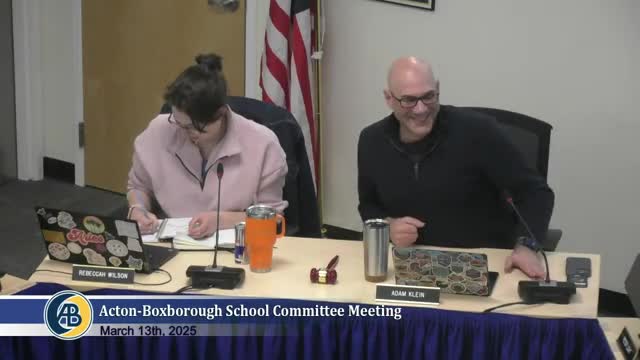District entry plan: administrators flag growing student needs, recommend focus on Tier 1 instruction and curriculum processes
March 14, 2025 | Acton-Boxborough Regional School District, School Boards, Massachusetts
This article was created by AI summarizing key points discussed. AI makes mistakes, so for full details and context, please refer to the video of the full meeting. Please report any errors so we can fix them. Report an error »

Dr. Gabby Abrams presented highlights from her seven‑month entry plan, describing broad takeaways from observations, conversations, data review and a faculty/family thought exchange.
Abrams said the district has many strengths — strong educator content knowledge, intentional social‑emotional supports, a visioning process (Vision of a Graduate) and growing, experienced leadership — but faces persistent challenges. Those include a rising share of students classified as “high needs,” persistent achievement gaps for high‑needs students, staffing limits in multilingual and library/media services, and scheduling constraints that complicate delivery of required supports.
Nut graf: Abrams recommended concentrating on Tier 1 (classroom) instruction and inclusive practices, strengthening curriculum‑mapping and review cycles, optimizing professional learning time to prioritize high‑leverage instructional strategies for multilingual and special‑needs students, and clarifying teacher‑leader roles to better support classroom instruction.
She presented aggregated district achievement snapshots showing strong performance among non‑high‑needs students (around the 80th percentile in aggregate MCAS-based proficiency measures) and substantially lower results for high‑needs students (approximately 34%–40% meeting proficiency), and stressed that closing that gap would require sustained work to ensure equitable access to grade‑level materials and high expectations.
Abrams listed several recommended operational steps: adopt systematic curriculum‑mapping and unit‑development protocols, expand work on equitable grading and consistent reporting, explore models to strengthen comprehensive wellness (Whole School, Whole Community, Whole Child framework), and examine creative scheduling or blended‑learning approaches to mitigate instructional time lost to absences or pull‑outs.
Committee members asked clarifying questions about the percentage of students categorized as high needs (Abrams said roughly one‑third), strategies used in other districts to narrow achievement gaps, the district’s approach to missed instructional days and blended‑learning models, and whether wellness work could reduce choice or raise equity concerns. Abrams said many recommended changes would be shaped through the upcoming strategic‑planning and reorganization work.
Ending: Committee members praised the presentation and welcomed Abrams’ suggestions; the district will fold the entry plan findings into the strategic‑planning and reorganization process and follow up with more detailed proposals and timelines.
Abrams said the district has many strengths — strong educator content knowledge, intentional social‑emotional supports, a visioning process (Vision of a Graduate) and growing, experienced leadership — but faces persistent challenges. Those include a rising share of students classified as “high needs,” persistent achievement gaps for high‑needs students, staffing limits in multilingual and library/media services, and scheduling constraints that complicate delivery of required supports.
Nut graf: Abrams recommended concentrating on Tier 1 (classroom) instruction and inclusive practices, strengthening curriculum‑mapping and review cycles, optimizing professional learning time to prioritize high‑leverage instructional strategies for multilingual and special‑needs students, and clarifying teacher‑leader roles to better support classroom instruction.
She presented aggregated district achievement snapshots showing strong performance among non‑high‑needs students (around the 80th percentile in aggregate MCAS-based proficiency measures) and substantially lower results for high‑needs students (approximately 34%–40% meeting proficiency), and stressed that closing that gap would require sustained work to ensure equitable access to grade‑level materials and high expectations.
Abrams listed several recommended operational steps: adopt systematic curriculum‑mapping and unit‑development protocols, expand work on equitable grading and consistent reporting, explore models to strengthen comprehensive wellness (Whole School, Whole Community, Whole Child framework), and examine creative scheduling or blended‑learning approaches to mitigate instructional time lost to absences or pull‑outs.
Committee members asked clarifying questions about the percentage of students categorized as high needs (Abrams said roughly one‑third), strategies used in other districts to narrow achievement gaps, the district’s approach to missed instructional days and blended‑learning models, and whether wellness work could reduce choice or raise equity concerns. Abrams said many recommended changes would be shaped through the upcoming strategic‑planning and reorganization work.
Ending: Committee members praised the presentation and welcomed Abrams’ suggestions; the district will fold the entry plan findings into the strategic‑planning and reorganization process and follow up with more detailed proposals and timelines.
View full meeting
This article is based on a recent meeting—watch the full video and explore the complete transcript for deeper insights into the discussion.
View full meeting
